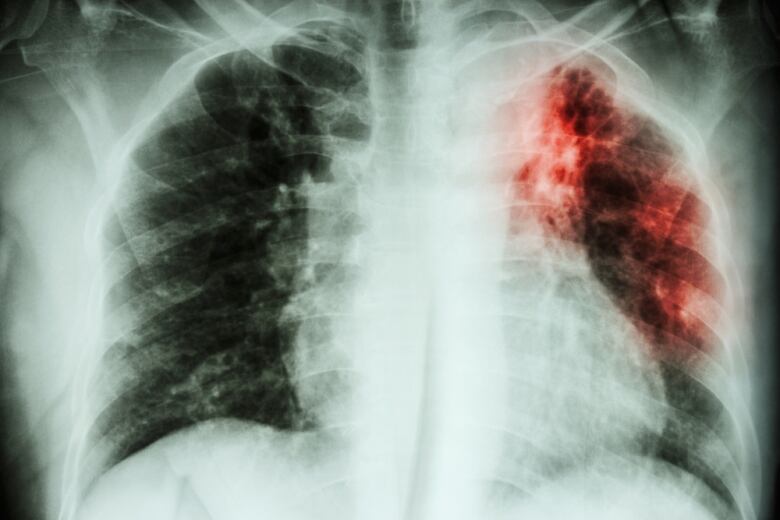Canadians must hold government accountable in Nunavut's tuberculosis outbreak
Dr. Sarah Giles, a family physician, says depth and scale of problem needs more attention

The depth and scale of this problem should leave every Canadian outraged.
Most Canadians think of poor countries when they think about tuberculosis (TB), adisease intimately connected with substandard living conditions.
Last year, 100 people in Nunavut were diagnosed with active TB a number many Canadians would find shocking.
To put that number in perspective, Nunavut now has the same incidence rate of TB as Somalia, 261 cases per 100,000. The rest of Canada has an incidence rate of only 0.6 cases per 100,000 people.
With rare exceptions, such as when children like 15-year-old Ileen Kooneeliusie of Qikiqtarjuaq, die from the disease, as she did in January 2017, the Canadian media have not reported on the longstanding problem in the North.
Some Canadians may be aware of the March announcement by the federalgovernment and Inuit Tapiriit Kanatami (ITK), the national representative organizationfor Inuit in Canada, which vowed to eliminate tuberculosis in the northern regions of Canada inhabited by Inuit by 2030. The federal government also pledged $27 million to eliminate TB in Inuit communities.
This may not be enough.
- Ottawa vows to eliminate tuberculosis in Inuit communities by 2030
- Major effort underway to fight tuberculosis outbreak in Qikiqtarjuaq, Nunavut

Stopping outbreak a 'herculean effort'
The proposed spending comes at the same time that the incidence rate of tuberculosis has hit crisis levels in Nunavut. Stopping the current outbreak will require a herculean effort. Worse yet, the current TBoutbreak may be more extensive than we realize because the existing data are poor quality.
Tuberculosis has two forms: active and latent. When people are exposed, they firstdevelop latent TB a non-infectious form of the disease.
The current TBoutbreak may be more extensive than we realize.- Dr. Sarah Giles
Approximately five to 10 per cent of people with latent TB will develop active TB, which makes them sick. While most people think of TB as disease of the lungs, it can be found virtually anywhere in thebody, but is only contagious when it is in the lungs.
Agovernment report obtained through an access to information request showed an active TB rate of 1,020 per 100,000 infants more than one in 100 infants in Nunavut in 2017.
In the rest of Canada, the rate is just three infants in 100,000.
Though no babies died of tuberculosis in Nunavut in 2017, even successfully treated TB can cause lifelong health consequences, such as cognitive impairment.
Because babies develop active TB quickly; TB in infants indicates high levels of disease circulating in a community.
Nunavut only tracking active cases
At present, Nunavut only tracks active cases of TB but not latent cases.
People who have latent TB and are at high risk of developing active TB, such as those with weakened immune systems or kidney failure, can be offered preventative treatment but thegovernment of Nunavut does not keep track of those who are offered preventativetreatment or those who complete, decline, or fail to finish treatment.
It is important to track people with latent tuberculosis.
They do not have symptoms, but they can convert to active TB and spread the disease, believing they simply have a cough.

After decreasing in incidence for decades, TB surged in the late 1990s when Nunavutwas created.
A perfect storm of complacency from low incidence rates at the time (31 in100,000 in 1997), a shortage of the purified protein derivative that helps to diagnose TB, and the dismantling of the Public Health Agency of Canada's Canadian Tuberculosis Committee and its Aboriginal Scientific Tuberculosis Subcommittee in 2011 resulted in TB spreading with little attention.
Further, the population boom in Nunavut coupled with poor social determinants of health,the underfunding of Inuit health care, the legacy of mistrust caused when people with TBwere removed from their families and taken to southern sanitariums, and a shortage of human resources, such as nurses, allowed TB to become the widespread life-threatening problem it is today.
Stopping a TB outbreak requires aggressive treatment of those with latent TB to decreasethe reservoir of disease in a community. Unfortunately, this means treating people who may never develop active TB.
Thankfully, a new drug regimen for the treatment of latent tuberculosis only requires treatment once per week for 12 weeks, rather than the old grueling schedule of nine months of daily observed treatment.
Though the task force to eliminate TB in Inuit Nunangat the Inuit regions in Canada faces serious challenges, there are reasons for hope.
The effort is being led by Inuit Tapiriit Kanatami and its approach of using local knowledge and stakeholders should be more culturally sensitive than past strategies. The simplified drug regimen may encourage more people to finish treatment, and federal funding could allow public health officials to slowly gain the upper hand in this challenging disease.
Canadians, and the Canadian media, must hold our governments to account.
This column is part ofCBC'sOpinion section.For more information about this section, please read thiseditor'sblogandourFAQ.












_(720p).jpg)


 OFFICIAL HD MUSIC VIDEO.jpg)
.jpg)



























































































